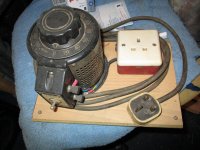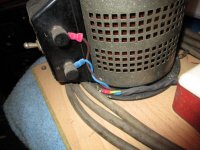I've been thinking about buying a variac for servicing tube amps.
I live in Finland where we have 230V line voltage. I've been looking at these devices on german ebay. My main concern is safety.
What do you think about this one?

Those screw in banana terminals look quite scary to me. OTOH the device is in a neat looking box. Some other ones seem to have like a US type wall socket. That doesn't help much here in the EU.
Here are some of the options if anyone is interested:
variac | eBay
I live in Finland where we have 230V line voltage. I've been looking at these devices on german ebay. My main concern is safety.
What do you think about this one?

Those screw in banana terminals look quite scary to me. OTOH the device is in a neat looking box. Some other ones seem to have like a US type wall socket. That doesn't help much here in the EU.
Here are some of the options if anyone is interested:
variac | eBay
I have to believe that there are commercial variac type units set up for 240v systems just as there are those for 120v. Those banana binding posts might be great in a lab, but I would not want that in my shop. Look for a unit with an approved type mains outlet.
An alternative is to buy a bare variac and build it into your own box with meters.
I guess for that matter, you could put a box around this variac too.
An alternative is to buy a bare variac and build it into your own box with meters.
I guess for that matter, you could put a box around this variac too.
Almost all cheap variable transformers listed on ebay are not designed for the EU market, as anyone will immediately see because they lack some safety features required to bear the CE logo. As example, the variac in your picture does uses banana terninals that are missing the extra insulation required for mains use, and it probably has further safety hazards such as improper internal wiring. You will find safe transformers at stores that sell to electrical installators. A popular cheap option here are the Metrel products https://www.metrel.si/assets/Metrel...groups_catalog/VAR/Ang/Group_2018_VAR_Ang.pdf
I have bought the M100 desktop version almost 10 years ago and it is still like new. Remember that regular variacs aren't insulation transformers, there is no galvanic separation from input to output.
I have bought the M100 desktop version almost 10 years ago and it is still like new. Remember that regular variacs aren't insulation transformers, there is no galvanic separation from input to output.
After some more searching I found this one. It seems to have the right kind of socket. Looks a bit safer too. I need to look into the Metrel brand too.
Here's the link.

Here's the link.

Last edited:
I just wonder if this provides galvanic isolation too.
Variacs do not provide any isolation.
I have two free standing units one being an isolating transformer and the other being the original they copied and painted red for the first post in this thread.
The input is hard wired like the bigger red one on mine.
The input is hard wired like the bigger red one on mine.
Attachments
I don't know many audio-geeks who truly need a 2KVA Variac.
I would think, in DIY-world, the variac in post #1 could be re-built more safe. Remove front box. Remove bananas. Enlarge and grommet those holes. Cut a local-flavor extension cord in half to make male and female ends. Bring those through the grommets and make right tight internal connections. Green to inside stud or come out to the obvious external ground screw. Of course this has a chance of burning down the house, so if you are not real comfortable, don't do it. (Even then, test it outside for smoke and fire.)
I would think, in DIY-world, the variac in post #1 could be re-built more safe. Remove front box. Remove bananas. Enlarge and grommet those holes. Cut a local-flavor extension cord in half to make male and female ends. Bring those through the grommets and make right tight internal connections. Green to inside stud or come out to the obvious external ground screw. Of course this has a chance of burning down the house, so if you are not real comfortable, don't do it. (Even then, test it outside for smoke and fire.)
You could add a commercial plug and socket over the top of banana plugs to provide fully enclosed ac wiring.
do you have a plug in cheap power meter - well worth it.
also an earth leakage breaker just for your bench.
a wise person also pulls out the equipment plug, rather than relying on the switch (eg. of the variac).
do you have a plug in cheap power meter - well worth it.
also an earth leakage breaker just for your bench.
a wise person also pulls out the equipment plug, rather than relying on the switch (eg. of the variac).
With a variac, always use:
RCCB or earth fault breaker
Fusing
Primary ammeter (and knowledge of the current rating of variac)
Secondary volt meter
Power resistors (BIG) Or a light bulb in series with the output from the secondary when first powering up.
I've never had any need or concern to use an isolating transformer. Best practice is to isolate supply nearest to the source (probably the RCCB or MCB in the electric box)
RCCB or earth fault breaker
Fusing
Primary ammeter (and knowledge of the current rating of variac)
Secondary volt meter
Power resistors (BIG) Or a light bulb in series with the output from the secondary when first powering up.
I've never had any need or concern to use an isolating transformer. Best practice is to isolate supply nearest to the source (probably the RCCB or MCB in the electric box)
I don't know many audio-geeks who truly need a 2KVA Variac.
That's cuz you live in Maine where there is no necessity of airconditioning!
I bought a 2KVA variac from a fellow who used it to ramp up the voltage on his window air conditioner when Jersey Central P&L had frequent brown-outs!
(We don't get no stinkin' brown-outs anymore, just black-outs!)
I have two variable transformers. One is a Variac, purchased at great expense about 40 years ago from Farnell and is an isolating 240v in with up to 270v out at 500v/A. I recently fitted new brushes and it still works a treat. The other I bought not so long ago, about 35 years I think. I purchased it from a transformer manufacturing company in the UK. I ordered a 300v/A auto variable transformer and to my surprise they sent the wrong one rated at 3kvA. For the same price as carriage back was a lot of money and it was their error, they said to keep it. Bonus I thought and that supplied, in real time, my large industrial bench at my workshop, working through a 3kvA isolating transformer, under the bench.
I don't think I have used the large one since retiring 5 years ago. The stuff we collect when in business.
I don't think I have used the large one since retiring 5 years ago. The stuff we collect when in business.
...it's not allowed to sell them anymore.....
As you say: there is usually a niche for *large* incandescents, larger than household bulbs, which are reasonably useful for large light in rarely-used spaces. My car-garage has six 150W hot-bulbs, because I need big light, and I only use them a dozen hours a year to get in and out. Such lamps are still readily available, though not at the supermarket.
The primary point of a lamp-limiter is to avoid burning the wall-wires. Any lamp you would safely use direct from your wall is obviously OK. (Lamps over 2KW might not be; but are much rarer.) A secondary use is to slow-down burn-up of the amplifier. For this you want a bulb "somewhat" larger than the expected normal power of the amplifier. For a 2*6L6 tube amp of 40W out, 100W in, a 150-250W lamp is appropriate.
Please, variac to site www.electrosheriff.com. I bougth there varic 500 va, quiet enough..
I second the recommendation to build your own. For one, you can build it in a less annoying form factor like a 3U rack-mount chassis (maybe I'm just a nerd who likes to rack-mount everything).
Second, it's really nice to have voltage and current meters. You can also build an isolation transformer into the same chassis. Control transformers can work great for that, and big ones aren't expensive.
Second, it's really nice to have voltage and current meters. You can also build an isolation transformer into the same chassis. Control transformers can work great for that, and big ones aren't expensive.
Moi!
Not sure if you have found wahat you were looking for yet, but I thought I'd share what I'm using for amp repairs. The isolation transformer is only up to 2.6 amps, but I've never found that to be problem. The other socket bypasses the variac, the current limiting bulb and the isolation transformer. Both have RCD and 10 Amp fuse that trips before the 16 A one at the fuse box. Transformers are protected with a 2.5 slow blow. Sometimes wish I could plug another 100W light bulb in parallel but other then that I'm pretty pleased.
power - Google Photos
Not sure if you have found wahat you were looking for yet, but I thought I'd share what I'm using for amp repairs. The isolation transformer is only up to 2.6 amps, but I've never found that to be problem. The other socket bypasses the variac, the current limiting bulb and the isolation transformer. Both have RCD and 10 Amp fuse that trips before the 16 A one at the fuse box. Transformers are protected with a 2.5 slow blow. Sometimes wish I could plug another 100W light bulb in parallel but other then that I'm pretty pleased.
power - Google Photos
- Home
- Design & Build
- Equipment & Tools
- Variac buying advice needed, safety concerns

